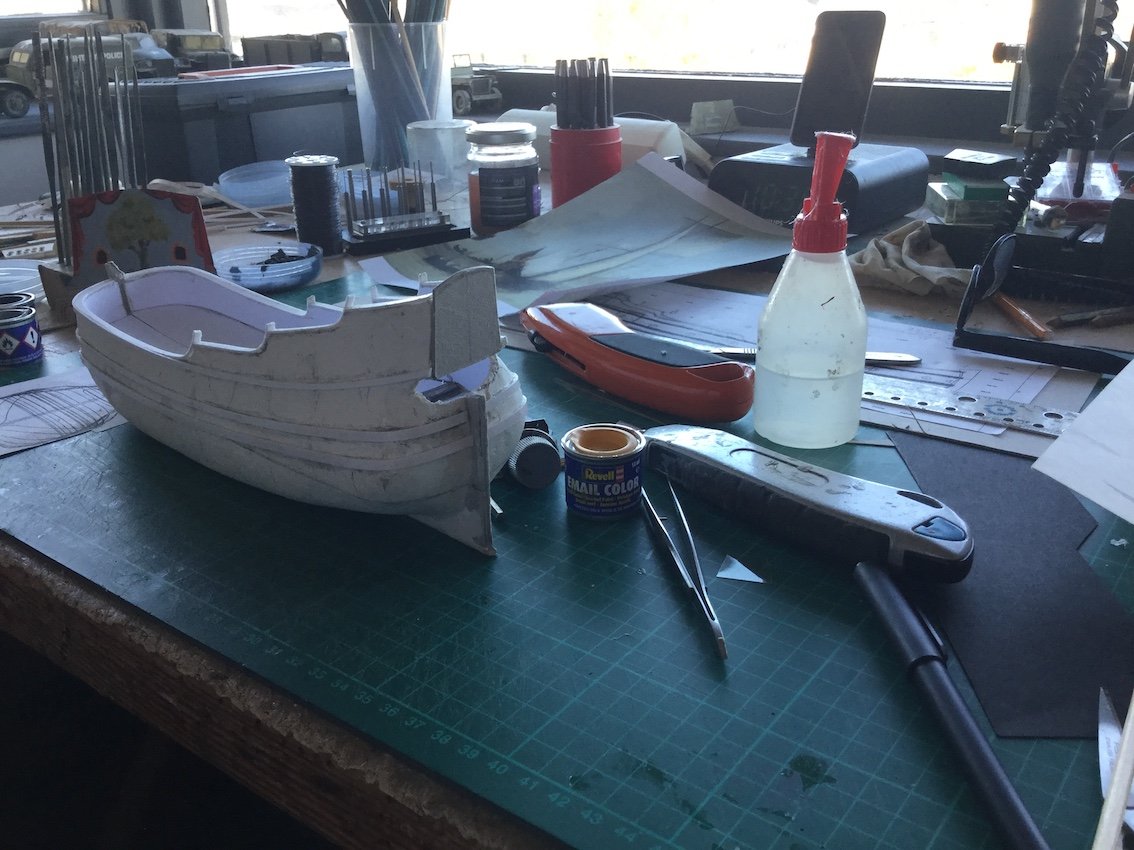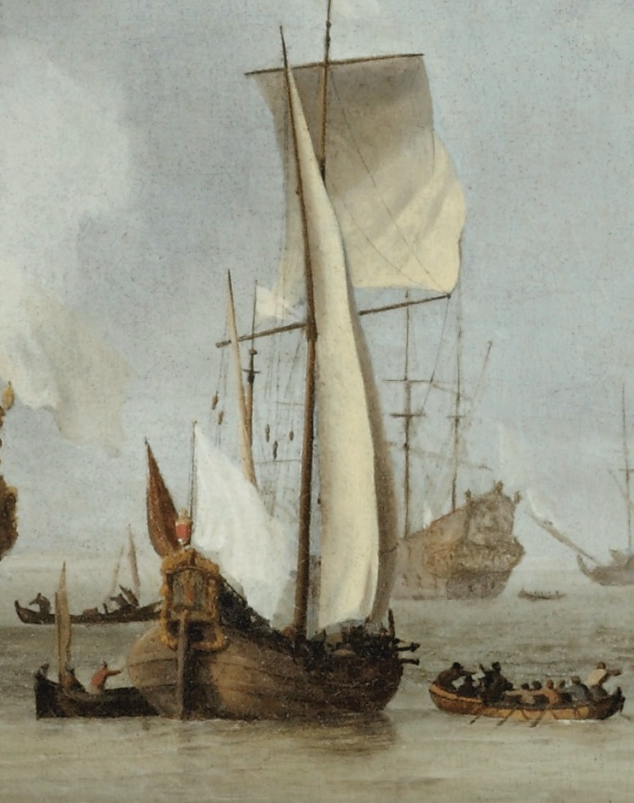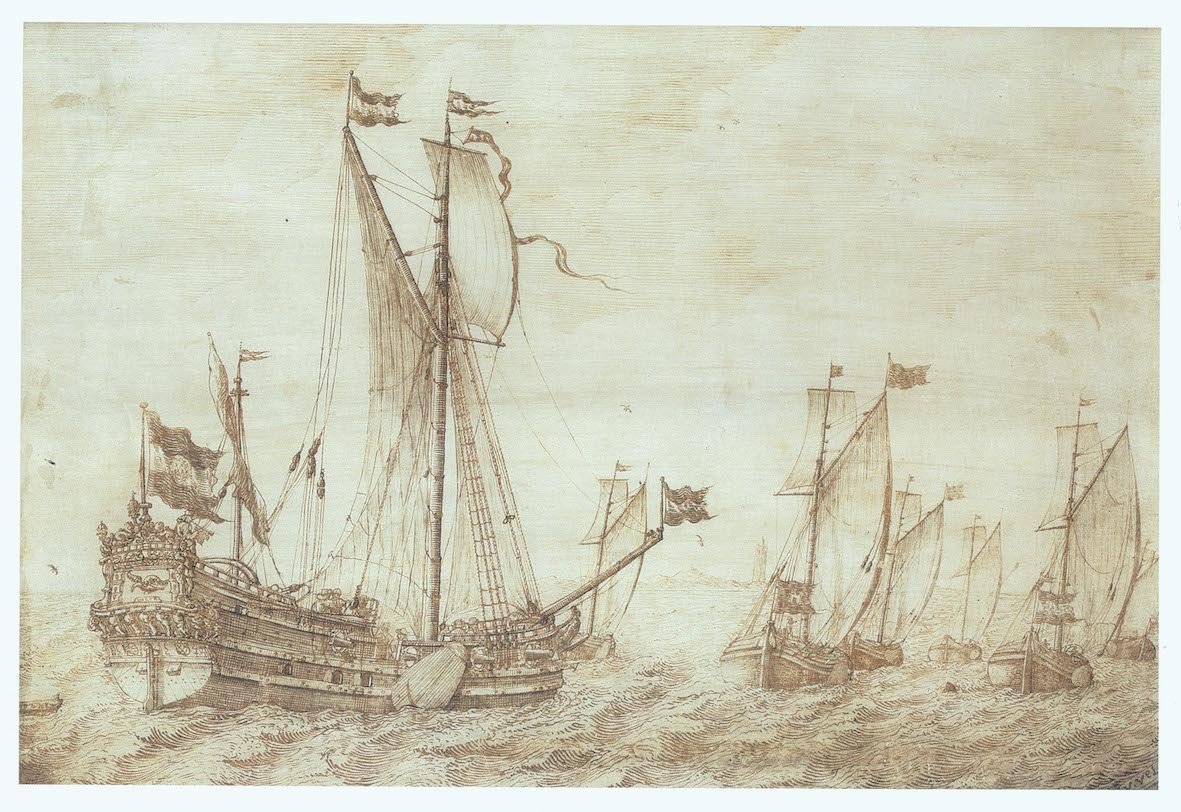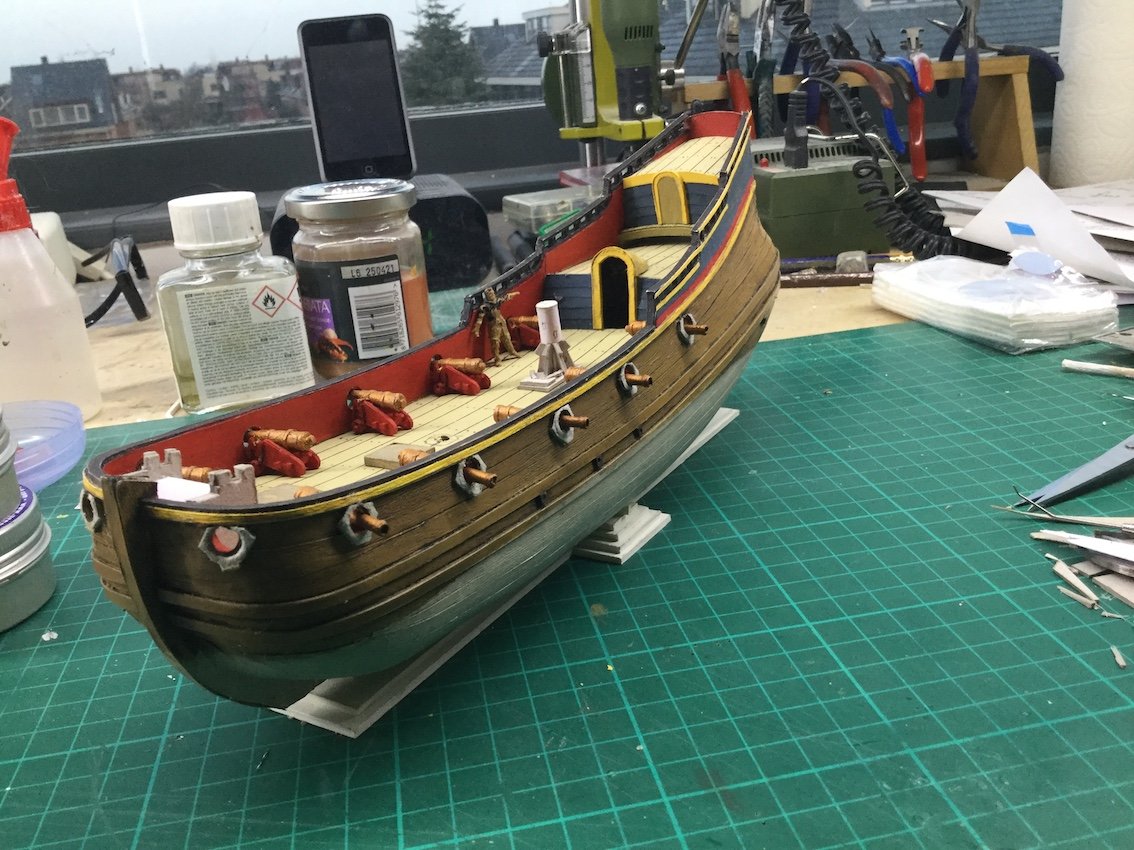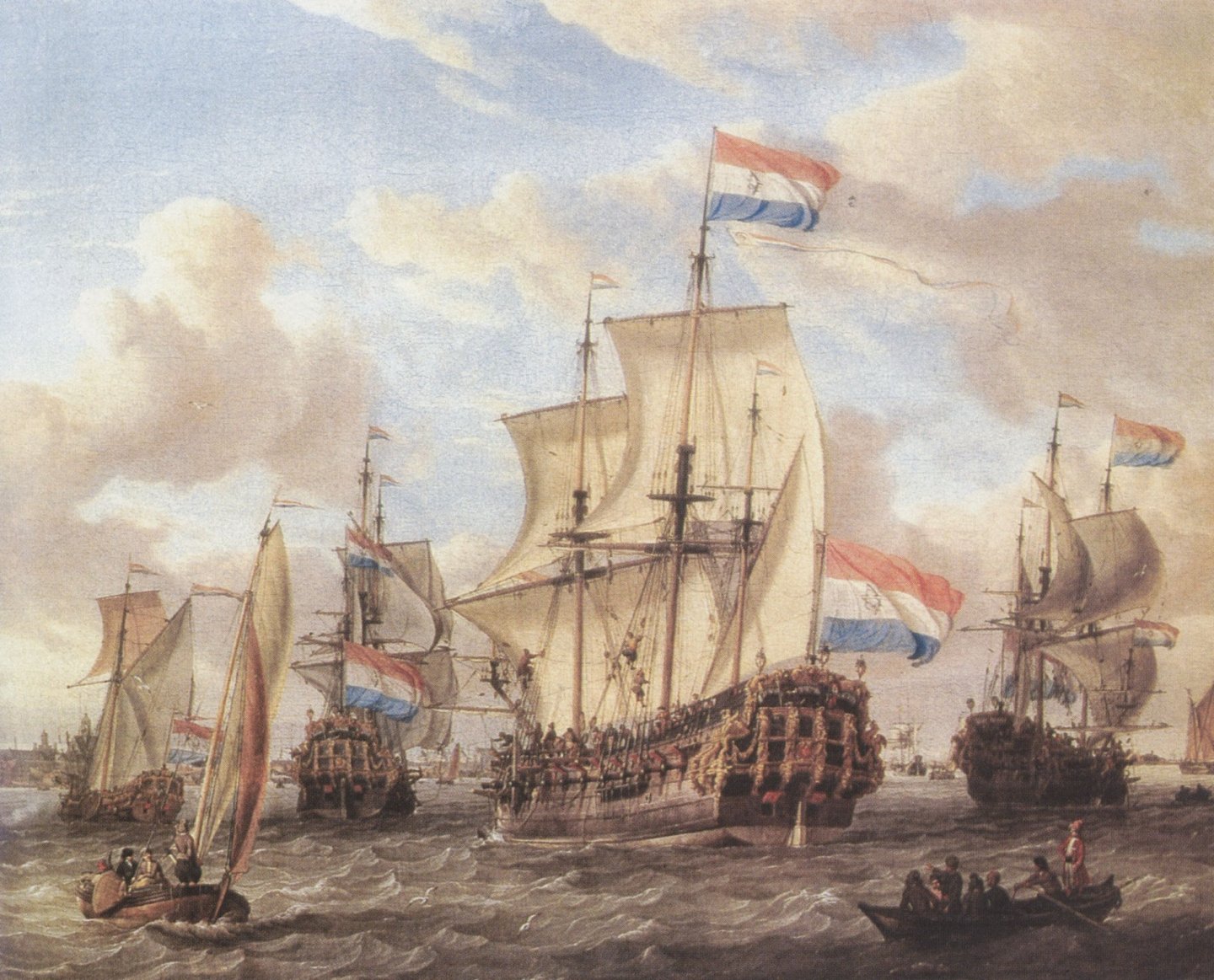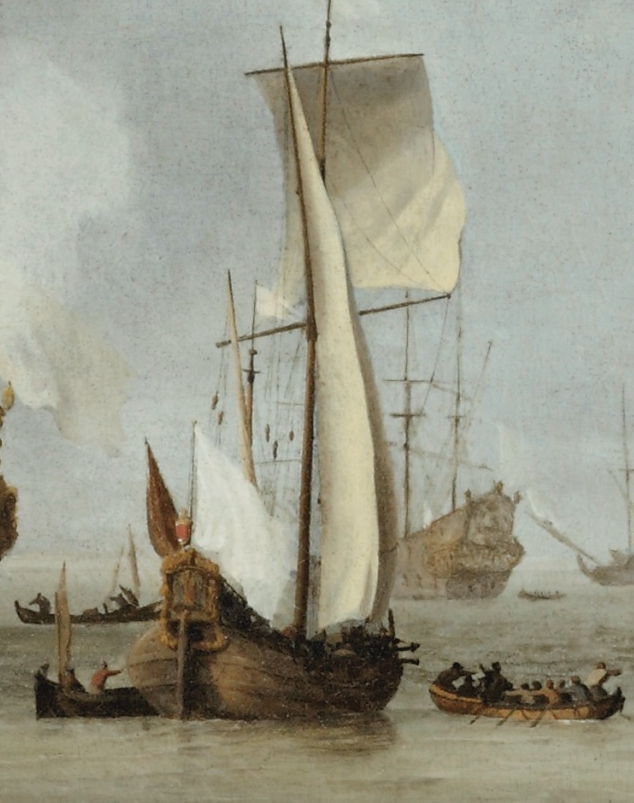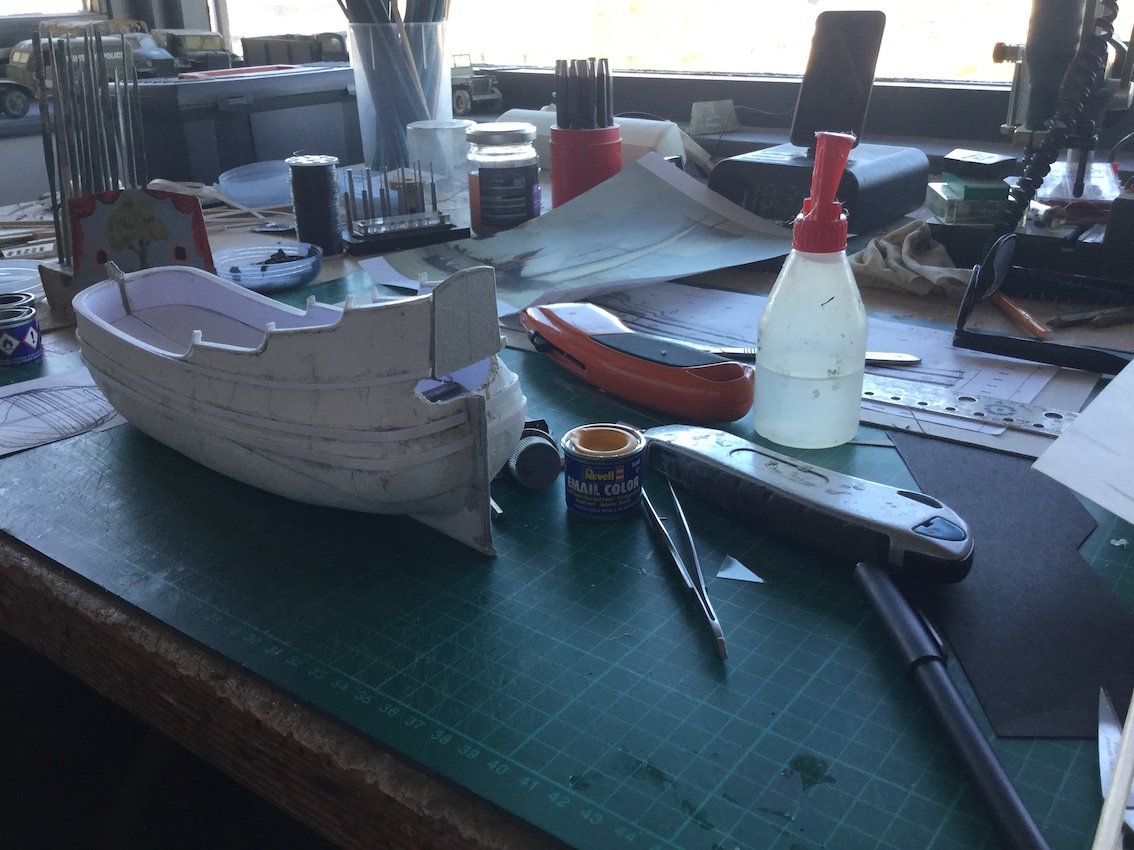-
Posts
545 -
Joined
-
Last visited
Content Type
Profiles
Forums
Gallery
Events
Everything posted by Ab Hoving
-
Ron, as to your remark about the chainwales of the model at different heights, I think I know what the reason for that is. I was Park Canada's guest in the nineties in Ottawa, when this project was in its early stages. Robert Grenier and Brad Loewen studied this Basque whaling ship, which was found in Red Bay in a very inventive way: all the parts that were found at the seabed were meticulously measured and executed in wood at a 1/10 scale, inclusive all holes for trunnels and nails. The original wood was put back into the water for better preservation. In the lab all the separate parts were put together again, thus trying to unveil the method of building. I am sure that the chainwales that were found, only fitted where they were placed on the model. I agree it is unusual, but I know these researchers did a thorough job. That still does not explain the nasty rail on top in the back of the ship...
-
Remember Marcus: many people ran into the same problems with - as you do here. It is a very tricky shape to make. Many gave up. To tell you the truth, I discarded a small fluit-like model myself a month ago. (Edit: I just discovered that I told this story earlier. Sorry for that. It's the age, you know 🙂 ) I was trying my hand at a rather unknown type of ship, a 'wadconvooier', a small armed vessel to convoy merchants on the Zuiderzee between Amsterdam and the inlets between the islands up north the country. All I have as a source are some contemporary pictures, showing different vessels with the same function. On some pictures the type looks like a Statenjacht with an additional mizzen mast, on others it resounds the shape of a fluit. Nevertheless I (also) tried my hand at the fluit-like type and tried to get the widest point of the hull at the hight of the upper wale. I seriously failed because I used a design for another fluit, which was incorrect in this context. The model disappeared into the dustbin and I started anew. This is the Statenjacht-like type of the wadconvooier. To the left another 'watte convoyer' of unsure type. Probably fluit-like. Here an obvious fluit-like type. Mind the widest point at the second wale, where the man in the boat points at, as if he wants to warn me.... And here my first try, with a shape I did not like. As you can see the widest point is way too low. So it ended in the dustbin. And here the second try. The shape of the 'hips' comes closer to the one on the painting, but I'm still not completely convinced. This one might end up in the dustbin too... All I want to say Marcus, is that there is nothing to be ashamed of if you remove parts of your model, or even if you start all over again. Because remember, a mistake made in the beginning of the building process is like a pregnancy: it will only get more and more visible. 🙂 Now you still have the chance to improve your build. Take it. Ab
- 318 replies
-
- fluit
- abel tasman
-
(and 2 more)
Tagged with:
-
Not yet. But the good news is that the Rijksdienst voor Cultureel Erfgoed (Governmental Service for Cultural Inheritance) is almost finished with the preparations for bringing the 3D construction of Witsen's pinas online and there are plans to do the same with the fluit. There are still some barriers to overcome, but work, executed by a small firm called Tijdlab, is progressing fast and we hope to present the first online version in spring. I started pushing the project of the 3D presentation of the pinas (which is the only Dutch seventeenth century vessel we have all the data of) in 2006, but actually the reconstruction of the ship after contemporary data goes back to 1980, when I laid my hands on Witsen's book for the first time. The plans can be found here: https://nautarch.tamu.edu/shiplab/AbHoving.htm. The 3D work started in 2013, after the first initiatives stranded because of the financial crisis in 2008. I have good hope that we will be online early 2020. So be patient. Here an image of a walk on deck of the pinas:
- 318 replies
-
- fluit
- abel tasman
-
(and 2 more)
Tagged with:
-
Hi Marcus, Drastic, indeed. First: do you have a symmetry problem? Maybe it's the picture, but it looks like one side is closer to the middle than the other. Now your problem: you are making the hole for the helm much too big. Your planking ends way too early. You have to stretch the end of the planking as far as you can. Maybe things get clearer with a view on the unplanked stern of the fluit: This 3D representation was made with the help of my great 'partner in crime', Rene Hendrickx. As you can see the tops of the frame parts rise above the highest wale, so your planking should continue there as well. That will close the gap for a big part. Then you will end up with something like this: I hope this helps. Ab
- 318 replies
-
- fluit
- abel tasman
-
(and 2 more)
Tagged with:
-
Judged from the picture of your paper model you surely didn't bad. And you are right, the smell of wood is one of the secret treasures of life. But paper is faster to build with and once you get the hang of it, the result shows little difference with wood. I especially like the beautiful sheer of your model. Something I cannot say about the replica of the San Joan. Why is the top rail in the aft part of the ship visually dropping? I doubt if any shipbuilder of the past would accept such a horrible line. And for no obvious reason...
-
Hello Ron, Thank you, I am totally convinced. Still it is peculiar that the hight was as much as that. We've seen it in the Wasa in Stockholm. Incredibly high decks, and we all know how that ended.🙂 It seems useless to give a ship so much hight where is was neither necessary for the length of the people, nor for the hight of the guns, which was very low. And added to the number of decks fore and aft, which are sometimes visible on pictures, once should be inclined to have some doubts. No, no, although the way you worked your way through the available material is worth a paper in any case. No, what I meant was, that this hull shape could be a very nice template for a model built in paper. Perhaps you have seen my tutorial on building with paper (although in Eastern Europe you can find model builders on every street corner who are much more capable in the execution of the build). There are people out there who make beautiful paper kits of ships like this one...
-
Good! Perhaps you might consider to do the measuring from the waterline to the wales as well. It might prevent a bad curve...
- 318 replies
-
- fluit
- abel tasman
-
(and 2 more)
Tagged with:
-
Hello Ron, I am surprised to hear that I even have fans in Moskou :-). Your build is inspirational, especially because of the thorough research you have done. I remember I looked at the material for a long time because it is interesting to reach beyond the borders of the written data but never succeeded in making good plans from what was available, but you did it. You succeeded in getting a fine line in your design. Chapeau! I do have some positive criticism though. As you know the average number of frames for vessels of this era is 60-70. As the tops of your frames show on the inside of your bulwarks it might be an idea to add extra frames, quite simple as separate frame tops. They don't have to be worked into the top rail or the waterway but I'm sure they will improve the looks of the model. I also have some doubts about the hight of the model. As you have showed the cannons of those days were very low, compared to guns on carriages of a century later. That implies that the hight between the decks could be made significantly lower. The fact that people could not stand straight was of no importance to the builders, 1.50 m must have been no exception. I think your decks have a more than comfortable hight. Don't start ripping your model to pieces, what I say is just an educated guess. Furthermore I have no remarks, except that this seems to be a beautiful project to execute in paper. It will take away much of the costs that come with wooden kits. Just a suggestion...
-
Brilliant ideas often miss their aim in daily practice. When I joined the museum in 1989 it was practice to show restorations in shipmodels, for instance by not painting the newly added parts or using different colors for rope, so any modern changes were visible at once. The backdraw of that system is, that the viewer is still not looking at an object in a state in which it originally was. In fact the only parts of an object he keeps on looking at are the restorer’s corrections. We deliberately abandoned that method and kept precise reports of what was done to the objects instead. The object is for the public, the problems with keeping it in a presentable state is for the scientists. Total replacement of a rigging might be a no-no, but what if the complete rigging drops on the floor the moment it is touched? Tests to chemically repair the broken fibres in rope show that the result hardly looks like the same rope in better days. In theory some ideas seem so appropriate...untill the harsh reality shows its face. By the way, it is a remarkable fact that the idea of showing the restorations on the historical objects was never applied in the painting department, the museum’s most prominent workshop. One must be a genius to see what has been restored on our Rembrandts and Vermeers. Still, for technical objects like ship models the method of showing restorations seemed appropriate? In some cases yes, perhaps, in other cases no, rather not. Every objects asks for its own theoretic and practical solutions.
-
Thank you for the undeserved praise, Justin. I doubt that there is a consensus on this side of the ocean for what I have done. What I think is interesting in your answer is that you mention curators who want things to be like new. Over here it is most important that the age of the object shows, being restored or not. A restorer is much more criticized for working too clean than for delivering a product that shows its age. Especially with metal objects it is hard not to make them too shiny. I remember a large brass quarter of a dry-dock which had to be restored and was therefore placed a few days in a reservoir with water with a mild cleaning agent. It came out shining like gold and that caused something like a panic under curators. As an experiment we once treated one of the pewter candlestick holders found on Nova Zembla, where they were left by discoverer Willem Barentsz in 1597 when he stranded there on his way to China through the North, with a very mild electric current in a basic bath (we call it electrolyse, but I can't remember the English term for it). It came out quite nice and clean, but panic again... I agree that for students it is important to know that every step they take should be considered over and over again, so you are doing your teachers job perfectly. The proces is to be reconsidered in every phase. Dogma's are good als long as one can deviate from them. I sometimes was jealous at my collegues of the painting restoration workshop one floor below my attic. They have the choice to select a method from a limited number of regular treatments, all tested and scientifically researched. In my field of work every restoration was a new experiment. Every object asked for its own treatment and there were a lot of methods to choose from. Many restorations were pure inventions, which made the work challenging every single day. Never a dull moment. Thanks also for the clips of the painting restorers. To many people the treatments seem extremely rude and messy, but as could be seen, there was no harm done (although I doubt I would have delivered the object as new as these ones. But fortunately I was not a painting restorer ). It is a beautiful profession and I enjoyed my existence in the museum every single day. As for the figurehead: we deliberately did not fill all the cracks and kept the guilding a bit 'damaged', as you can see here: https://www.rijksmuseum.nl/nl/zoeken/objecten?q=boegbeeld&p=3&ps=12&st=Objects&ii=5#/NG-NM-11549,29
-
I was afraid this was going to happen when I first saw this thread and I must say I am rather unwilling to jump in, because I cannot find my way through all these well-educated opinions and propositions. But as there seems to be no escape: here is my 50cents opinion. If I learned one golden rule about restoration/restoring, it must be that there is no golden rule. Hundreds of historical objects passed my hands in the 23 years of my active career in the Rijksmuseum and even looking back at all the processes of recovering or maintaining original objects I still cannot find a general line in the treatment of all of them. It is an unflinching law that everything that exists will disappear over the years and we can only try to stall that proces. Of course I must have 'repaired' some ship models in a way some of you would call a crime. But hey, what is the point in finding a beautiful but dismantled 17th century hull of a very rare 40-gun man-of-war and leaving it in that state, if such a model is needed in the museum's presentation. Is it allowed to take off the 20th century paint with which it was mistreated and rig it in the way how it to my best knowledge should be done? Of course I did all that and I'm proud I did. On the other hand I saw many ship models pass my workbench of which the running rigging was deteriorated beyond repair, but which still had a perfect standing rigging. I would be mad if I replaced both parts of the rigging. Whatever is still intact, I keep it that way. Fortunately I am a lazy person and nothing is better for a historical object than falling into the hands of a lazy restorer. But anything that is literally falling to dust has to be replaced. We had models in the depot which we passed on tiptoes because any shock would cause rigging parts to fall off. There is something I have to add here. Being a conservator in a museum mainly presenting art objects I always tried to fight for my own place between my respected collegues. A ship model in my opinion is not a work of art, although out of admiration we are most willing to judge it so if the build was done in exquisite way. But in reality it is a depiction of something technical. It shows for instance how the rigging was done, which allowed the vessel to sail the oceans. If such parts turn into dust (and I have seen many examples of that, carefully rubbing it between my fingers and ending with nothing but dust) and you want to maintain the intention of the maker, showing a working rigging, what harm have you done replacing the missing part with material as close as you can get? (The Victory in Portsmouth seems to be 'renewed' for over 90 % so I was told. Should all the rotten pieces have been still there, sooner or later we would have ended up with a pile of debris.) What is always interesting to see is the attitude of the curators. If we lived in a perfect world the curator was to be the one to say yes or no to a restoration or a technique. In practice dealing with objects is something completely different from what an average curator has studied. Doing archives was his training, not dealing with objects. So what happens is that the conservator (or restorer if you like) makes the decisions and carries them out. Next the curator ceremonially cries out about the mistreatment of the object, immediately followed by its placement in the showcase to show it to the public. I experienced this literally with an old figurehead of a knight in armor which was in a terrible state. Me and my co-operator closed the many cracks, re-applied the guilding and paint (after intensive research), added missing wooden bolts and repaired the not-original stand, at the same time suggesting a better solution to present the object. For a short time we were the talk the town and the next thing that happened was the installation of the object as it was in the hall as an eye-catcher. It is still there.... The bottom line? There is no golden rule. I applaud every researcher trying to find solutions to maintain old objects that show their age and I am most willing to apply any solution to solve problems without intervening in the object, but I am not a chemist, I only know a lot about ships and their ins and outs and I would be lying if I denied that every object I had in my hands has taught me something. The museum allowed me to have an extensive library both on technical ship-matters and on conservation techniques and I have always loved to find a happy marriage between the two. If you want one unavoidable rule in this matter it must be a deep love and respect for the object, but I'm sure every participant in this discussion feels that too, with apparently totally different outcomes.
-
I usually start with the waterline. You can simply do that by placing the model on an improvised stand and scribe the waterline with a pencil on a block. Then you can take the hight of the decks on several locations from the draught and mark them on the outside of the hull.
- 318 replies
-
- fluit
- abel tasman
-
(and 2 more)
Tagged with:
-
Beautiful Drazen, you both are master model builders! Ab
-
Hello Eberhart, Thank you for enlightening this peculiar thread of which the content seems to wonder into various directions with a nice view on Amsterdam in the 17th century.:-) This is surely a pleasure vessel. We know it under the name of 'kopjacht', a name I cannot explain. It is more often depicted on paintings of special occasions on the water, like this one, dealing with the visit of the Czar Peter the Great to Amsterdam in 1697-98. Another attractive type for model building...
-
Glad you take it this way Marcus. I didn't realize you planned a double planking. In that case I would do my best to sand the first planking up to a degree that nothing is left of the irregularities you caused by rather random planking. I would even go as far as using filler to get a smooth and even surface to lay the outer planking on. You might consider a layer of white paint so you can draw the lines of the planking directly on the hull. I don't know how you want to attach that planking. Just glue? It may be a bit late for an advice, but I think the use of balsa wood for spacers between frames is rather useless. I don't consider balsa wood as wood. You cannot use nails or dowels in that stuff. Any kind of wood would have been better, as it would have given you the opportunity to choose the locations of nails or dowels. Now you can only use your plywood frames. Plywood is useless in modelbuilding too. Another fairytale from the kit business. Where you stand now, you might just as well have built a solid hull, carving it into the right shape. Or you will have to give real building a try: Start with keel and posts and build your frames and planking like in the real thing. Have you read Harold Underhill's Plank-on-frame Models? I can recommend it. Ab
- 318 replies
-
- fluit
- abel tasman
-
(and 2 more)
Tagged with:
-
Jan is 100% right. Traditional shipbuilding is not an invention. It is an endles developing process that goes back to the bronze age (3000-800 b.C.), consisting of small steps forwards (and sometimes backwards). It took ages before it got to what is described for the first time in Dutch literature in 1671. There were no alternatives though. Because the method of designing ships hulls on paper was not invented yet (here you really have an invention) there was no possibility to do it frame-first. Traditional rules-of-thumb were all our ancestors had. Now is that impressive or not?
-
Hello Marcus, I want to make a few remarks about your planking. Sorry I didn't keep up with this thread but seeing your planking only now you deserve some clues because of your impressive drive to build this difficult model. The first thing you should let go is thinking that a ship can be planked with straight strips from fore to aft. It is a wide-spread misunderstanding caused by kit makers that straight strips can plank a round model. In reality there is not a single straight plank in a ship's outside planking. Take wider strips and shape them according to the shape of the ship: they look like crooked sabres. Never force the wood, treat it gently and it will do what you want without splitting or breaking. Twisting wood in different directions for instance is a proces that can only be done by applying heat, and only after you have made sure that the piece of plank you are applying really fits its destination. You show my Zeehaen model from the pictures in the book, but if you really study those pictures, you should see that every strake of planking consists of at least three separate pieces of wood and mostly more. Bending wood with heat (for instance a flame of a candle) is a technique you can master if you apply pressure to the hot wood and feeling that it gives way at a certain moment. That's how you get the shape. If you can mount the plank without using force, that's when you are on the right track. Secondly the mounting of the wales is, like you said yourself, crucial. If they are in the right location and have the right curve, very little can go wrong. Now look at your side view and ask yourself: is the curve of my whale flawless? I don't think you can say yes. You gave it a lot of attention, but you missed it slightly. A solution could be another technique: dress the unplanked hull with a wide strip of paper and draw the lines of the wales on it until you finally feel you have the shape right. Don't decide at once. Try to find a satisfying shape and put the model away for a few days. Then look at it again and repeat the proces. If you are satisfied with the run, take off the paper and cut the wales. You will see how curved the shape is. It also helps measuring if you draw a waterline on the unplanked hull for reference. It diminishes the problem of orientation and gives you a landmark to work from. This is really challenging stuff. I can honestly tell you that I'm wrestling with the shape of the hips of fluits up to today, even though I built quite a few. Recently I was trying my hand on a 'wadconvooier', a small armed admiralty vessel, used to protect merchants on the 'Zuiderzee'. It is not a ship type, but rather a function, for which several types were used. One of them really looks like a fluit, but shows another type of rig. I thought I could use old plans for another fluit I made by rescaling the draught. I was wrong. The result was another candidate for the dustbin where it is now, because the hips were placed too low: Finding the right curves is the most challenging part of the proces. And there is only one way to learn: the hard way.
- 318 replies
-
- fluit
- abel tasman
-
(and 2 more)
Tagged with:
-
Congratulations with your work Glenn. It must be years ago that we met in College Station. Keep good memories of that event. Ab
-

Twist in the lower shrouds/ratlines
Ab Hoving replied to mugje's topic in Masting, rigging and sails
In my opinion you don’t have to remove the ratlines to tighten the shrouds. I always leave my lanyards more or less loose until the ratlines are done. Then you can easily tighten them, taking care that the shrouds are stretched in an even way.
About us
Modelshipworld - Advancing Ship Modeling through Research
SSL Secured
Your security is important for us so this Website is SSL-Secured
NRG Mailing Address
Nautical Research Guild
237 South Lincoln Street
Westmont IL, 60559-1917
Model Ship World ® and the MSW logo are Registered Trademarks, and belong to the Nautical Research Guild (United States Patent and Trademark Office: No. 6,929,264 & No. 6,929,274, registered Dec. 20, 2022)
Helpful Links
About the NRG
If you enjoy building ship models that are historically accurate as well as beautiful, then The Nautical Research Guild (NRG) is just right for you.
The Guild is a non-profit educational organization whose mission is to “Advance Ship Modeling Through Research”. We provide support to our members in their efforts to raise the quality of their model ships.
The Nautical Research Guild has published our world-renowned quarterly magazine, The Nautical Research Journal, since 1955. The pages of the Journal are full of articles by accomplished ship modelers who show you how they create those exquisite details on their models, and by maritime historians who show you the correct details to build. The Journal is available in both print and digital editions. Go to the NRG web site (www.thenrg.org) to download a complimentary digital copy of the Journal. The NRG also publishes plan sets, books and compilations of back issues of the Journal and the former Ships in Scale and Model Ship Builder magazines.



